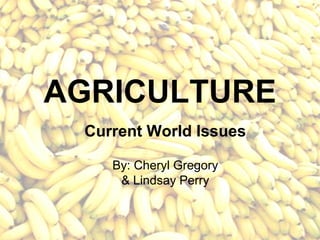
Agriculture
- 1. AGRICULTURE Current World Issues By: Cheryl Gregory & Lindsay Perry
- 2. Agricultural Problems • Production to Population Ratio • Trade: Feast vs. Famine • Water Contamination • Soil Degradation • Plant & Animal Disease • Native Biomass Destruction
- 3. Current Problematic Practices • Mono-cropping • Chemical Farming • Poor Trade Regulations • Poor Land Management • Use of Non-Native Species
- 4. Mono-Cropping Def: Use of a single species over a large land area without rotation BENEFITS COSTS 1. Increased Yield 1. Decreased Biodiversity (Within 2. Specialization of Labor & crop DNA and Outside of Crop Industrial Technology population) 3. Surplus for Trade 2. Increased Susceptibility to Pests & Pathogens 3. Soil Nutrient Depletion 4. Chemical Dependence Increased Chemical Use Increased Water Contamination
- 5. Inorganic Chemical Farming • Def: Use of synthetic fertilizers, pesticides, plant-growth regulators, antibiotics, additives or GMOs (Genetically Modified Organisms) BENEFITS COSTS 1. Ability to Monocrop 1. Water/Soil Contamination 2. Use of Non-Native Species 2. Harm to Local Wildlife 3. Predictable Outcome 3. Increased Resistance of Pests/Pathogens 4. Allergic Reaction in Humans
- 6. Poor Trade Regulations • WTO (World Trade Org.) & GATT (General Agreement on Tariffs & Trade) – Promote Trade Liberalization • Theoretically: cheap & efficient production b/c everyone does what they ‘do best’ • Realistically: lower worker wages & disregard of environ. impact – “THE RACE TO THE BOTTOM” • WTO bars countries from using trade policy to discriminate on the basis of production methods FAOSTAT: resource for world agro-trade info.
- 7. Poor Land Management Def: Allocation of land without regard for current or future environmental impact Examples: 1. Extensive Deforestation 2. Abandonment of Farmland Desertification & Increase in Invasive Species Sediment Pollution of Water
- 8. Non-Native Species Why use non-native species? • Market DEMAND • Open Land • Looser Regulations • Established Production Method Problems: • Evolution into Invasive Species •Def: Introduced Species without Predetorial or Environmental Control • Decreased Yield
- 9. Tropical Case Study: Bananas • Biggest Exporters: Ecuador, Costa Rica, Phillipines, Columbia – None are Native Banana Environments!!!! • Biggest Importers: USA, Euro., Japan, Russia • Transnational Co.s produce 40%Harvest & 58% Exports (May 1996) • Costa Rica: Bananas account for 21.7% Foreign Currency Income (May 1996)
- 10. Agricultural Problems • Production to Population Ratio • Trade: Feast vs. Famine • Water Contamination • Soil Degradation • Plant & Animal Disease • Native Biomass Destruction
- 11. Current Problematic Practices • Mono-cropping • Chemical Farming • Poor Trade Regulations • Poor Land Management • Use of Non-Native Species
- 12. Tropical Case Study: Bananas Massive Monoculture Plantations • Deforestation of Tropical Forests – Decreased biodiversity – Loss of Habitats sediment in oceans destruction of ~90% of coral reefs on Costa Rica’s Caribbean Cost • Increased Suseptibility to Pathogens Panama Disease Valerie Clone which requires higher chemical use • Soil Depletion Decreased Future Yields & Increased Fertilizer Use
- 13. Tropical Case Study: Bananas Extensive Chemical Use • Banana Plantations account for the highest use of chemicals • Water/Soil Contamination – 90% of Pesticides sprayed by plane lost to wind-drift, soil, and rain • DBCP Cancer, Birth Defects, Sterility etc. (not just humans!) • >10% higher instances of fertility and organ damage in persons associated w/ plantations www.bananasthemovie.com/.../documents.jpg
- 15. Tropical Case Study: Bananas Poor Trade Regulation • Nearly Monopolized Trade System – 5 companies control more than 90% of the banana trade • Problems With EU – Misrepresentation of Smaller/Poorer Countries – Control Markets for Benefit of Importer • Example of the Effect of Politics on Environment: 1960’s Ecuador Nationalized Market Co’s moved to Costa Rica Increased Competition in C.R. Increased Production Intensity Land Destruction
- 16. Tropical Case Study: Bananas • Poor Land Management – 1872: Land to Minor Keith In Exchange for Railroad Money Non-Native Species • Do bananas grow better in Asia? •Higher Yields •Could C.R. grow a native crop, such as pejibaye, more efficiently? http://waynesword.palomar.edu/images/peji5b.jpg
- 17. Possible Alternatives • Niche Markets: – G Word- Costa Rica Banana Growers http://www.youtube.com/watch?v=EjVc66Fn_Uc • Changing Production Methods – Ex: Do not spray pesticides from planes. Use a more direct form of application
- 18. Sustainable Organic Agriculture • International Federation of Organic Agriculture Movements DEFINITION-Organic agriculture is a production system that sustains the health of soils, ecosystems and people. It relies on ecological processes, biodiversity and cycles adapted to local conditions, rather than the use of inputs with adverse effects. Organic agriculture combines tradition, innovation and science to benefit the shared environment and promote fair relationships and a good quality of life for all involved.
- 19. Sustainable Organic Agriculture • Principles of organic agriculture address all major Agricultural issues • Sales of Certified Organic products grow 20-25% yearly • Supply/Demand! • Big Picture-Increasing Population will always pressure sustainable ecosystem functions
- 20. References • IFOAM: http://www.ifoam.org/about_ifoam/principles/index.html • Lotter. ,D.W. 2003. Organic Agriculture Journal of Sustainable Agriculture 21. (4) • Nelson PhD, Scot. 2006. Poly and Monocultures: The Good, the Bad, and the Ugly.Univ. of Hawai’i at Manoa. (4-6) • Human Land Use, Agriculture, Pesticides and Losses of Imperiled Species – Katherine E. Gibbs, Robin L. Mackey and David J. Currie – Diversity and Distributions, Vol. 15, No. 2 (Mar., 2009), pp. 242-253 – Published by: Blackwell Publishing • Evaluating and Managing the Environmental Impact of Banana Production in Costa Rica: A Systems Appro... more – Carlos E. Hernandez and Scott G. Witter – Ambio, Vol. 25, No. 3 (May, 1996), pp. 171-178 – Published by: Allen Press on behalf of Royal Swedish Academy of Sciences • Banana Link – http://www.bananalink.org/uk – Built by www.nfn.org.uk – Hosted on a memset dedicated server